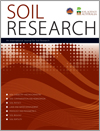SR20013Importance of sugarcane straw maintenance to prevent soil organic matter depletion in a Nitisol in the central-southern region of Brazil
 , Arthur K. B. Santos
, Arthur K. B. Santos  , Paul L. A. Melo
, Paul L. A. Melo  , Maurício R. Cherubin
, Maurício R. Cherubin  , Carlos E. P. Cerri
, Carlos E. P. Cerri  and Marcos Siqueira-Neto
and Marcos Siqueira-Neto 
Crop residue inputs are fundamental to sustain and improve the soil health in agricultural cropping systems. We evaluated the impacts of sugarcane straw removal on soil organic parameters, and found that any straw removal in areas with low straw production will negatively affect soil quality. The results highlight the importance of balancing the amount of straw removed for bioenergy production and to keep environmental sustainability.




